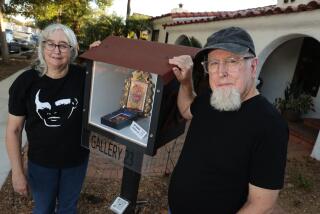Intricate Japanese Inro Boxes Star at Museum : Art: Pacific Asia displays an increasingly pricey 400-piece lacquer collection dating to the 17th Century.
- Share via
An extensive 400-piece exhibition of Japanese lacquer dating from the 17th to early 20th centuries at the Pacific Asia Museum in Pasadena has been drawing the attention of a small coterie of international art dealers and collectors from Europe, Canada and Japan.
Modestly titled “Japanese Lacquer From Southern California Collections,” the recently opened exhibit features works from 12 collectors, including a variety of techniques and subject matter. But the show’s particular allure is its unusual focus on the intricately designed inro, small tiered, interlocking boxes commonly worn by merchant classes in the pre-Meiji era, before 1867.
Since kimonos have no pockets, inro were first worn primarily by men to hold seals and inks, then later tobacco, pills and powders. They were originally imported from China and Korea in the 16th Century and were banished during the Meiji Restoration when traditional Japanese culture was rejected in favor of Westernization.
The Pasadena show also includes ojime, the carved beads that allowed inro to be opened and closed, and netsuke, the ivory or wood fastener that held them to the obi of a kimono. But the inro collection is getting the most scrutiny.
Driving the attention are events such as the Butterfield & Butterfield auction at the Netsuke Kenkyukai convention last month in San Francisco, where the top bid for an inro was “a spectacular” $16,500.
“High-end items went far beyond our estimation,” said B & B administrator Amanda Miller. “The ones we estimated between $2,500 and $4,000 went for $6,500. Only three of 64 inro did not sell. In general, netsuke did not do as well.”
In the last seven years, prices for inro have risen dramatically compared to netsuke, which grew in popularity in the early 1970s. Auction rooms had been quietly selling inro for relatively low prices until the 1980s.
Then last year an inro sold in Paris for more than $120,000 to a German collector, and, according to one dealer, the November sale of the Charles A. Greenfield collection sent price levels into the “empyrean” and affected the value of other inro of similar quality.
“But collectors aren’t obliged to buy those pieces,” said Paul Moss of Sydney L. Moss Ltd. of London. “While it’s true to say the really fine inro have moved up a level or two . . . and some feel left out in the cold, it’s more of a psychological conviction that they’re being bludgeoned out of the marketplace than any actual pressure. Things are bad but not that bad.”
Ironically, if any single group of buyers is being “left out in the cold” in terms of buying power, it’s the Japanese because the Moss auction house, like others, allows Western collectors to buy “special pieces” before placing inro on the public marketplace.
“Once that has happened, Japanese dealers are quite good at swiftly taking away many of the fine items which remain,” Moss said.
Some Japanese clients are knowledgeable and buy discriminately, but others at auction, Moss said, are fairly indiscriminate, appearing to aim for “flashy gold things” either for the nouveau riche or the tourist trade.
Longtime collectors such as Elly Nordskog and Virginia G. Atchley, president of the Netsuke Kenkyukai, whose works make up a significant portion of the Pacific Asia Museum exhibit, expressed regret over soaring prices for inro.
“We collect for the fun of it, not as an investment,” Atchley said. “Sometimes a group of us would get together to trade and swap pieces. When I brought back the (five-case) silver inro with black crows from an auction in Bonn, Germany, for example, I had a perfectly suitable ojime of a black crow and a collector friend of mine said, ‘I have the perfect netsuke for that.’ Now the prices are so outrageous, we could never do that.”
Two years ago when the Inro Museum of Takayama was collecting works for a new facility northwest of Tokyo, London dealers saw a great deal of activity as “medium” and “good” works were snapped up and shipped back to Japan. The museum opened last March with 300 inro, netsuke and ojime displayed flat in low, glass-topped cases.
In contrast, the small, 4x5-inch works at Pacific Asia Museum are hung with mirrors behind each piece to allow the viewer to see each piece’s reverse side. Museum curator David L. Kamansky has displayed the inro with silk cords tied in authentic knots.
“In the West, we think of the Japanese as people who lack individuality, who are good at repeating the same things,” Kamansky said. “But when you look at the variety of design techniques in this show, the subject matter, the history--it’s mind-boggling.”
Other fine examples of lacquer displayed include combs, pipe cases, sake sets, trays, large and small writing and storage boxes from the Joe and Etsuko Price collection.
At Pacific Asia Museum, 46 N. Los Robles Ave., Pasadena, Wed.-Sun., noon to 5 p.m., (818) 449-2742 through Thursday.
More to Read
The biggest entertainment stories
Get our big stories about Hollywood, film, television, music, arts, culture and more right in your inbox as soon as they publish.
You may occasionally receive promotional content from the Los Angeles Times.










